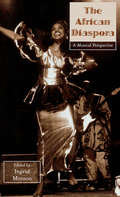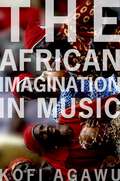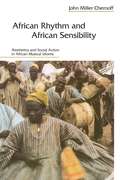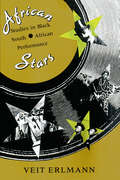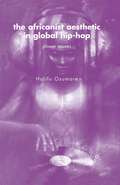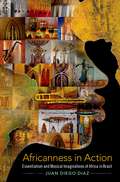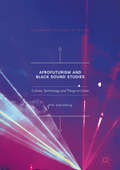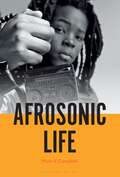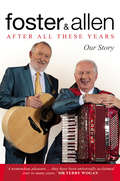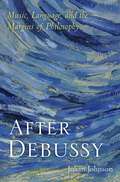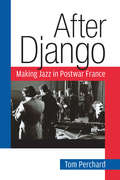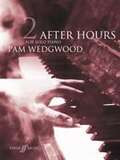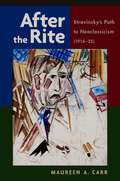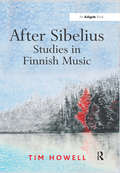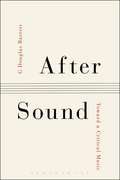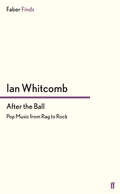- Table View
- List View
The African Diaspora: A Musical Perspective (Critical and Cultural Musicology)
by Ingrid MonsonThe African Diaspora presents musical case studies from various regions of the African diaspora, including Africa, the Caribbean, Latin America, North America, and Europe, that engage with broader interdisciplinary discussions about race, gender, politics, nationalism, and music. Featured here are jazz, wassoulou music, and popular and traditional musics of the Caribbean and Africa, framed with attention to the reciprocal relationships of the local and the global.
The African Diaspora: A Musical Perspective (Critical and Cultural Musicology)
by Ingrid MonsonThe African Diaspora presents musical case studies from various regions of the African diaspora, including Africa, the Caribbean, Latin America, North America, and Europe, that engage with broader interdisciplinary discussions about race, gender, politics, nationalism, and music. Featured here are jazz, wassoulou music, and popular and traditional musics of the Caribbean and Africa, framed with attention to the reciprocal relationships of the local and the global.
The African Imagination in Music
by Kofi AgawuThe world of Sub-Saharan African music is immensely rich and diverse, containing a plethora of repertoires and traditions. In The African Imagination in Music, renowned music scholar Kofi Agawu offers an introduction to the major dimensions of this music and the values upon which it rests. Agawu leads his readers through an exploration of the traditions, structural elements, instruments, and performative techniques that characterize the music. In sections that focus upon rhythm, melody, form, and harmony, the essential parts of African music come into relief. While traditional music, the backbone of Africa's musical thinking, receives the most attention, Agawu also supplies insights into popular and art music in order to demonstrate the breadth of the African musical imagination. Close readings of a variety of songs, including an Ewe dirge, an Aka children's song, and Fela's 'Suffering and Smiling' supplement the broader discussion. The African Imagination in Music foregrounds a hitherto under-reported legacy of recordings and insists on the necessity of experiencing music as sound in order to appreciate and understand it fully. Accordingly, a Companion Website features important examples of the music discussed in detail in the book. Accessibly and engagingly written for a general audience, The African Imagination in Music is poised to renew interest in Black African music and to engender discussion of its creative underpinnings by Africanists, ethnomusicologists, music theorists and musicologists.
AFRICAN IMAGINATION IN MUSIC C
by Kofi AgawuThe world of Sub-Saharan African music is immensely rich and diverse, containing a plethora of repertoires and traditions. In The African Imagination in Music, renowned music scholar Kofi Agawu offers an introduction to the major dimensions of this music and the values upon which it rests. Agawu leads his readers through an exploration of the traditions, structural elements, instruments, and performative techniques that characterize the music. In sections that focus upon rhythm, melody, form, and harmony, the essential parts of African music come into relief. While traditional music, the backbone of Africa's musical thinking, receives the most attention, Agawu also supplies insights into popular and art music in order to demonstrate the breadth of the African musical imagination. Close readings of a variety of songs, including an Ewe dirge, an Aka children's song, and Fela's 'Suffering and Smiling' supplement the broader discussion. The African Imagination in Music foregrounds a hitherto under-reported legacy of recordings and insists on the necessity of experiencing music as sound in order to appreciate and understand it fully. Accordingly, a Companion Website features important examples of the music discussed in detail in the book. Accessibly and engagingly written for a general audience, The African Imagination in Music is poised to renew interest in Black African music and to engender discussion of its creative underpinnings by Africanists, ethnomusicologists, music theorists and musicologists.
African Rhythm and African Sensibility: Aesthetics and Social Action in African Musical Idioms (Religion And Postmodernism Ser.)
by John Miller Chernoff"We have in this book a Rosetta stone for mediating, or translating, African musical behavior and aesthetics."—Andrew Tracey, African Music "John Miller Chernoff, who spent 10 years studying African drumming, has a flair for descriptive writing, and his first-person narratives should be easily understood by any reader, while ringing unmistakably true for the reader who has also been to West Africa."—Roderick Knight, Washington Post Book World "Ethnomusicologists must be proud that their discipline has produced a book that will, beyond doubt, rank as a classic of African studies."—Peter Fryer, Research in Literatures "A marvelous book. . . . Not many scholars will ever be able to achieve the kind of synthesis of 'doing' and 'writing about' their subject matter that Chernoff has achieved, but he has given us an excellent illustration of what is possible."—Chet Creider, Culture "Chernoff develops a brilliant and penetrating musicological essay that is, at the same time, an intensely personal and even touching account of musical and cultural discovery that anyone with an interest in Africa can and should read. . . . No other writing comes close to approaching Chernoff's ability to convey a feeling of how African music 'works'"—James Koetting, Africana Journal "Four stars. One of the few books I know of that talks of the political, social, and spiritual meanings of music. I was moved. It was so nice I read it twice."—David Byrne of "Talking Heads" The companion cassette tape has 44 examples of the music discussed in the book. It consists of field recordings illustrating cross-rhythms, multiple meters, call and response forms, etc.
African Stars: Studies in Black South African Performance (Chicago Studies in Ethnomusicology)
by Veit ErlmannIn recent years black South African music and dance have become ever more popular in the West, where they are now widely celebrated as expressions of opposition to discrimination and repression. Less well known is the rich history of these arts, which were shaped by several generations of black artists and performers whose struggles, visions, and aspirations did not differ fundamentally from those of their present-day counterparts. In five detailed case studies Veit Erlmann digs deep to expose the roots of the most important of these performance traditions. He relates the early history of isicathamiya, the a cappella vocal style made famous by Ladysmith Black Mambazo. In two chapters on Durban between the World Wars he charts the evolution of Zulu music and dance, studying in depth the transformation of ingoma, a dance form popular among migrant workers since the 1930s. He goes on to record the colorful life and influential work of Reuben T. Caluza, South Africa's first black ragtime composer. And Erlmann's reconstruction of the 1890s concert tours of an Afro-American vocal group, Orpheus M. McAdoo and the Virginia Jubilee Singers, documents the earliest link between the African and American performance traditions. Numerous eyewitness reports, musicians' personal testimonies, and song texts enrich Erlmann's narratives and demonstrate that black performance evolved in response to the growing economic and racial segmentation of South African society. Early ragtime, ingoma, and isicathamiya enabled the black urban population to comment on their precarious social position and to symbolically construct a secure space within a rapidly changing political world. Today, South African workers, artists, and youth continue to build upon this performance tradition in their struggle for freedom and democracy. The early performers portrayed by Erlmann were guiding lights—African stars—by which the present and future course of South Africa is being determined.
African Stars: Studies In Black South African Performance (Chicago Studies In Ethnomusicology Ser.)
by Veit ErlmannIn recent years black South African music and dance have become ever more popular in the West, where they are now widely celebrated as expressions of opposition to discrimination and repression. Less well known is the rich history of these arts, which were shaped by several generations of black artists and performers whose struggles, visions, and aspirations did not differ fundamentally from those of their present-day counterparts.In five detailed case studies Veit Erlmann digs deep to expose the roots of the most important of these performance traditions. He relates the early history of isicathamiya, the a cappella vocal style made famous by Ladysmith Black Mambazo. In two chapters on Durban between the World Wars he charts the evolution of Zulu music and dance, studying in depth the transformation of ingoma, a dance form popular among migrant workers since the 1930s. He goes on to record the colorful life and influential work of Reuben T. Caluza, South Africa's first black ragtime composer. And Erlmann's reconstruction of the 1890s concert tours of an Afro-American vocal group, Orpheus M. McAdoo and the Virginia Jubilee Singers, documents the earliest link between the African and American performance traditions. Numerous eyewitness reports, musicians' personal testimonies, and song texts enrich Erlmann's narratives and demonstrate that black performance evolved in response to the growing economic and racial segmentation of South African society. Early ragtime, ingoma, and isicathamiya enabled the black urban population to comment on their precarious social position and to symbolically construct a secure space within a rapidly changing political world. Today, South African workers, artists, and youth continue to build upon this performance tradition in their struggle for freedom and democracy. The early performers portrayed by Erlmann were guiding lights—African stars—by which the present and future course of South Africa is being determined.
The Africanist Aesthetic in Global Hip-Hop: Power Moves
by H. OsumareAsserting that hip hop culture has become another locus of postmodernity, Osumare explores the intricacies of this phenomenon from the beginning of the Twenty-First century, tracing the aesthetic and socio-political path of the currency of hip hop across the globe.
Africanness in Action: Essentialism and Musical Imaginations of Africa in Brazil (Currents in Latin American and Iberian Music)
by Juan Diego DíazWhen many people think of African music, the first ideas that come to mind are often of rhythm, drums, and dancing. These perceptions are rooted in emblematic African and African-derived genres such as West African drumming, funk, salsa, or samba and, more importantly, essentialized notions about Africa which have been fueled over centuries of contact between the "West," Africa, and the African diaspora. These notions, of course, tend to reduce and often portray Africa and the diaspora as primitive, exotic, and monolithic. In Africanness in Action, author Juan Diego Díaz explores this dynamic through the perspectives of Black musicians in Bahia, Brazil, a site imagined by many as a diasporic epicenter of African survivals and purity. Black musicians from Bahia, Díaz argues, assert Afro-Brazilian identities, promote social change, and critique racial inequality by creatively engaging essentialized tropes about African music and culture. Instead of reproducing these notions, musicians demonstrate agency by strategically emphasizing or downplaying them.
AFRICANNESS IN ACTION CILAM C: Essentialism and Musical Imaginations of Africa in Brazil (Currents in Latin American and Iberian Music)
by Juan Diego DíazWhen many people think of African music, the first ideas that come to mind are often of rhythm, drums, and dancing. These perceptions are rooted in emblematic African and African-derived genres such as West African drumming, funk, salsa, or samba and, more importantly, essentialized notions about Africa which have been fueled over centuries of contact between the "West," Africa, and the African diaspora. These notions, of course, tend to reduce and often portray Africa and the diaspora as primitive, exotic, and monolithic. In Africanness in Action, author Juan Diego Díaz explores this dynamic through the perspectives of Black musicians in Bahia, Brazil, a site imagined by many as a diasporic epicenter of African survivals and purity. Black musicians from Bahia, Díaz argues, assert Afro-Brazilian identities, promote social change, and critique racial inequality by creatively engaging essentialized tropes about African music and culture. Instead of reproducing these notions, musicians demonstrate agency by strategically emphasizing or downplaying them.
Afrofuturism and Black Sound Studies: Culture, Technology, and Things to Come
by Erik SteinskogThis book interrogates the meeting point between Afrofuturism and Black Sound Studies. Whereas Afrofuturism is often understood primarily in relation to science fiction and speculative fiction, it can also be examined from a sonic perspective. The sounds of Afrofuturism are deeply embedded in the speculative – demonstrated in mythmaking – in frameworks for songs and compositions, in the personas of the artists, and in how the sounds are produced. In highlighting the place of music within the lived experiences of African Americans, the author analyses how the perspectives of Black Sound Studies complement and overlap with the discussion of sonic Afrofuturism. Focusing upon blackness, technology, and sound, this unique text offers key insights in how music partakes in imagining and constructing the future. This innovative volume will appeal to students and scholars of sound studies, musicology and African American studies.
Afrofuturism and Black Sound Studies: Culture, Technology, and Things to Come
by Erik SteinskogThis book interrogates the meeting point between Afrofuturism and Black Sound Studies. Whereas Afrofuturism is often understood primarily in relation to science fiction and speculative fiction, it can also be examined from a sonic perspective. The sounds of Afrofuturism are deeply embedded in the speculative – demonstrated in mythmaking – in frameworks for songs and compositions, in the personas of the artists, and in how the sounds are produced. In highlighting the place of music within the lived experiences of African Americans, the author analyses how the perspectives of Black Sound Studies complement and overlap with the discussion of sonic Afrofuturism. Focusing upon blackness, technology, and sound, this unique text offers key insights in how music partakes in imagining and constructing the future. This innovative volume will appeal to students and scholars of sound studies, musicology and African American studies.
Afrosonic Life
by Mark V. CampbellAfrosonic Life explores the role sonic innovations in the African diaspora play in articulating methodologies for living the afterlife of slavery. Developing and extending debates on Afrosonic cultures, the book attends to the ways in which the acts of technological subversion, experimentation and production complement and interrupt the intellectual project of modernity. Music making processes such as dub, turntablism, hip-hop dj techniques and the remix, innovate methods of expressing subjecthoods beyond the dominant language of Western “Man” and the market. These sonic innovations utilize sound as a methodology to institute a rehumanizing subjectivity in which sound dislodges the hierarchical ordering of racial schemas. Afrosonic Life is invested in excavating and elaborating the nuanced and novel ways of music making and sound creation found in the African diaspora.
Afrosonic Life
by Mark V. CampbellAfrosonic Life explores the role sonic innovations in the African diaspora play in articulating methodologies for living the afterlife of slavery. Developing and extending debates on Afrosonic cultures, the book attends to the ways in which the acts of technological subversion, experimentation and production complement and interrupt the intellectual project of modernity. Music making processes such as dub, turntablism, hip-hop dj techniques and the remix, innovate methods of expressing subjecthoods beyond the dominant language of Western “Man” and the market. These sonic innovations utilize sound as a methodology to institute a rehumanizing subjectivity in which sound dislodges the hierarchical ordering of racial schemas. Afrosonic Life is invested in excavating and elaborating the nuanced and novel ways of music making and sound creation found in the African diaspora.
After All These Years: Our Story
by Mick Foster Tony AllenThis is the combined life story of Mick Foster and Tony Allen, revealing how these most unlikely of stars toured the world and entered the record books. A charming narrative told with heaps of Celtic charm, it is filled with nostalgic reminiscences about growing up in rural Ireland in the 1950s and 60s, and spans the breadth of their long career, including appearing on Top of the Pops alongside Bob Geldof and being feted by Terry Wogan, and the extraordinary moment when they found themselves at the very top of the charts, beating Take That to the number-one slot.
After Debussy: Music, Language, and the Margins of Philosophy
by Julian JohnsonClassical music shows a close relationship to language, and both musicology and philosophy have tended to approach music from that angle, exploring it in terms of expression, representation, and discourse. This book turns that idea on its head. Focusing on the music of Debussy and its legacy in the century since his death, After Debussy offers a groundbreaking new perspective on twentieth-century music that foregrounds a sensory logic of sound over quasi-linguistic ideas of structure or meaning. Author Julian Johnson argues that Debussy's music exemplifies this idea, influencing the music of successive composers who took up the mantle of emphasizing sound over syntax, sense over signification. In doing so, this music not only anticipates a central problem of contemporary thought--the gap between language and our embodied relation to the world--but also offers a solution. With a readable narrative structure grounded in an impressive body of literature, After Debussy ranges widely across French music, demonstrating the impact of Debussy's music on composers from Fauré and Ravel to Dutilleux, Boulez, Grisey, Murail and Saariaho. It ranges similarly through a set of French writers and philosophers, from Mallarmé and Proust to Merleau-Ponty, Jankélévitch, Derrida, Lyotard and Nancy, and even draws from the visual arts to help embody key ideas. In accessibly tackling substantial ideas of both musicology and philosophy, this book not only presents bold new ways of understanding each discipline but also lays the groundwork for exciting new discourse between them.
After Debussy: Music, Language, and the Margins of Philosophy
by Julian JohnsonClassical music shows a close relationship to language, and both musicology and philosophy have tended to approach music from that angle, exploring it in terms of expression, representation, and discourse. This book turns that idea on its head. Focusing on the music of Debussy and its legacy in the century since his death, After Debussy offers a groundbreaking new perspective on twentieth-century music that foregrounds a sensory logic of sound over quasi-linguistic ideas of structure or meaning. Author Julian Johnson argues that Debussy's music exemplifies this idea, influencing the music of successive composers who took up the mantle of emphasizing sound over syntax, sense over signification. In doing so, this music not only anticipates a central problem of contemporary thought--the gap between language and our embodied relation to the world--but also offers a solution. With a readable narrative structure grounded in an impressive body of literature, After Debussy ranges widely across French music, demonstrating the impact of Debussy's music on composers from Fauré and Ravel to Dutilleux, Boulez, Grisey, Murail and Saariaho. It ranges similarly through a set of French writers and philosophers, from Mallarmé and Proust to Merleau-Ponty, Jankélévitch, Derrida, Lyotard and Nancy, and even draws from the visual arts to help embody key ideas. In accessibly tackling substantial ideas of both musicology and philosophy, this book not only presents bold new ways of understanding each discipline but also lays the groundwork for exciting new discourse between them.
After Django: Making Jazz in Postwar France (Jazz Perspectives)
by Tom PerchardHow did French musicians and critics interpret jazz—that quintessentially American music—in the mid-twentieth century? How far did players reshape what they learned from records and visitors into more local jazz forms, and how did the music figure in those angry debates that so often suffused French cultural and political life? After Django begins with the famous interwar triumphs of Josephine Baker and Django Reinhardt, but, for the first time, the focus here falls on the French jazz practices of the postwar era. The work of important but neglected French musicians such as André Hodeir and Barney Wilen is examined in depth, as are native responses to Americans such as Miles Davis and Thelonious Monk. The book provides an original intertwining of musical and historical narrative, supported by extensive archival work; in clear and compelling prose, Perchard describes the problematic efforts towards aesthetic assimilation and transformation made by those concerned with jazz in fact and in idea, listening to the music as it sounded in discourses around local identity, art, 1968 radicalism, social democracy, and post colonial politics.
After Hours For Solo Piano, Bk 2 (Faber Edition: After Hours Ser. #Bk 2)
by Pam WedgwoodAfter Hours Book 2 is the second in a series of five books by Pam Wedgwood, arranged for the Grade 4-6 pianist. It is a further collection of new and original pieces in a variety of styles to suit any mood - from sentimental ballads to cosy dinner jazz, wistful blues to cheerful, upbeat tunes - providing the perfect antidote to stress. So conjure up the dimly lit atmosphere of a jazz club, and relax with these lush harmonies and laid-back melodies.
After Sibelius: Studies in Finnish Music
by Tim HowellDuring the last twenty years, the rest of the world has come to focus on the music of Finland. The seemingly disproportionate creative energy from this small country defies prevalent trends in the production of classical music. Tim Howell provides an engaging investigation into Finnish music and combines elements of composer biography and detailed analysis within the broader context of cultural and national identity. The book consists of a collection of eight individual composer studies that investigate the historical position and compositional characteristics of a representative selection of leading figures, ranging from the beginning of the twentieth century to the present day. These potentially self-contained studies subscribe to a larger picture, which explains the Sibelian legacy, the effect of this considerable influence on subsequent generations and its lasting consequences: an internationally acclaimed school of contemporary music. Outlining a particular perspective on modernism, Howell provides a careful balance between biographical and analytical concerns to allow the work to be accessible to the non-specialist. Each composer study offers a sense of overview followed by progressively more detail. Close readings of selected orchestral works provide a focus, while the structure of each analysis accommodates the different levels of engagement expected by a wide readership. The composers under consideration are Aarre Merikanto, Erik Bergman, Joonas Kokkonen, Einojuhani Rautavaara, Aulis Sallinen, Paavo Heininen, Kaija Saariaho and Magnus Lindberg. The concluding discussion of issues of national distinctiveness and the whole phenomenon of why such a small nation is compositionally so active, is of wide-ranging significance. Drawing together various strands to emerge from these individual personalities, Howell explores the Finnish attitude to new music, in both its composition and reception, uncovering an enlightened view of the value of creativity from which
After Sibelius: Studies in Finnish Music
by Tim HowellDuring the last twenty years, the rest of the world has come to focus on the music of Finland. The seemingly disproportionate creative energy from this small country defies prevalent trends in the production of classical music. Tim Howell provides an engaging investigation into Finnish music and combines elements of composer biography and detailed analysis within the broader context of cultural and national identity. The book consists of a collection of eight individual composer studies that investigate the historical position and compositional characteristics of a representative selection of leading figures, ranging from the beginning of the twentieth century to the present day. These potentially self-contained studies subscribe to a larger picture, which explains the Sibelian legacy, the effect of this considerable influence on subsequent generations and its lasting consequences: an internationally acclaimed school of contemporary music. Outlining a particular perspective on modernism, Howell provides a careful balance between biographical and analytical concerns to allow the work to be accessible to the non-specialist. Each composer study offers a sense of overview followed by progressively more detail. Close readings of selected orchestral works provide a focus, while the structure of each analysis accommodates the different levels of engagement expected by a wide readership. The composers under consideration are Aarre Merikanto, Erik Bergman, Joonas Kokkonen, Einojuhani Rautavaara, Aulis Sallinen, Paavo Heininen, Kaija Saariaho and Magnus Lindberg. The concluding discussion of issues of national distinctiveness and the whole phenomenon of why such a small nation is compositionally so active, is of wide-ranging significance. Drawing together various strands to emerge from these individual personalities, Howell explores the Finnish attitude to new music, in both its composition and reception, uncovering an enlightened view of the value of creativity from which
After Sound: Toward a Critical Music
by G Douglas BarrettAfter Sound considers contemporary art practices that reconceive music beyond the limitation of sound. This book is called After Sound because music and sound are, in Barrett's account, different entities. While musicology and sound art theory alike typically equate music with pure instrumental sound, or absolute music, Barrett posits music as an expanded field of artistic practice encompassing a range of different media and symbolic relationships. The works discussed in After Sound thus use performance, text scores, musical automata, video, social practice, and installation while they articulate a novel aesthetic space for a radically engaged musical practice. Coining the term "critical music," this book examines a diverse collection of art projects which intervene into specific political and philosophical conflicts by exploring music's unique historical forms. Through a series of intimate studies of artworks surveyed from the visual and performing arts of the past ten years-Pussy Riot, Ultra-red, Hong-Kai Wang, Peter Ablinger, Pauline Boudry and Renate Lorenz, and others-After Sound offers a significant revision to the way we think about music. The book as a whole offers a way out of one of the most vexing deadlocks of contemporary cultural criticism: the choice between a sound art effectively divorced from the formal-historical coordinates of musical practice and the hermetic music that dominates new music circles today.
After Sound: Toward a Critical Music
by G Douglas BarrettAfter Sound considers contemporary art practices that reconceive music beyond the limitation of sound. This book is called After Sound because music and sound are, in Barrett's account, different entities. While musicology and sound art theory alike typically equate music with pure instrumental sound, or absolute music, Barrett posits music as an expanded field of artistic practice encompassing a range of different media and symbolic relationships. The works discussed in After Sound thus use performance, text scores, musical automata, video, social practice, and installation while they articulate a novel aesthetic space for a radically engaged musical practice. Coining the term "critical music," this book examines a diverse collection of art projects which intervene into specific political and philosophical conflicts by exploring music's unique historical forms. Through a series of intimate studies of artworks surveyed from the visual and performing arts of the past ten years-Pussy Riot, Ultra-red, Hong-Kai Wang, Peter Ablinger, Pauline Boudry and Renate Lorenz, and others-After Sound offers a significant revision to the way we think about music. The book as a whole offers a way out of one of the most vexing deadlocks of contemporary cultural criticism: the choice between a sound art effectively divorced from the formal-historical coordinates of musical practice and the hermetic music that dominates new music circles today.
After the Ball: Pop Music from Rag to Rock (Limelight Ser.)
by Ian WhitcombFirst published in 1972, Ian Whitcomb's After the Ball is an exuberant account of the origins and explosion of popular music, informed by the author's store of experience in the field as a pop sensation of The Sixties.'Brash, learned, funny and perspicacious.... The author of this free-wheeling, diverting history was a student at Trinity College, Dublin, when he created a rock hit 'You Turn Me On,' and experienced a brief, bewildering season as a touring rock celebrity. This book... is his effort to explain that experience to himself, and, well-educated man that he is, he goes all the way back to the first pop bestseller (in sheet music, of course), 'After The Ball,' and all the way forward to the 1960s.' New Yorker 'One of the best books on popular music to come along in the last few years.... Whitcomb's own involvement with music constantly surfaces to make the book both revealing and highly enjoyable.' Seattle Times
